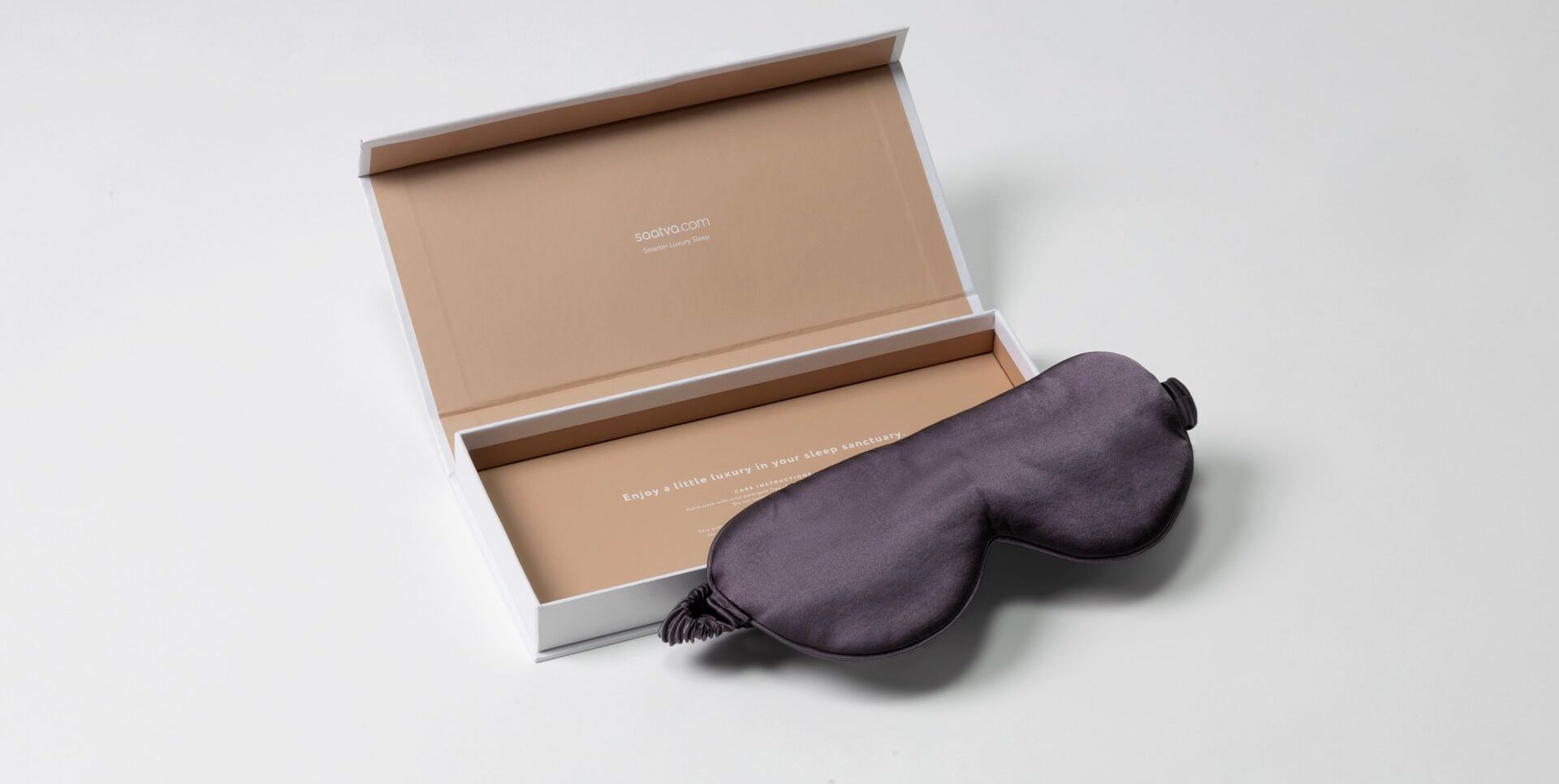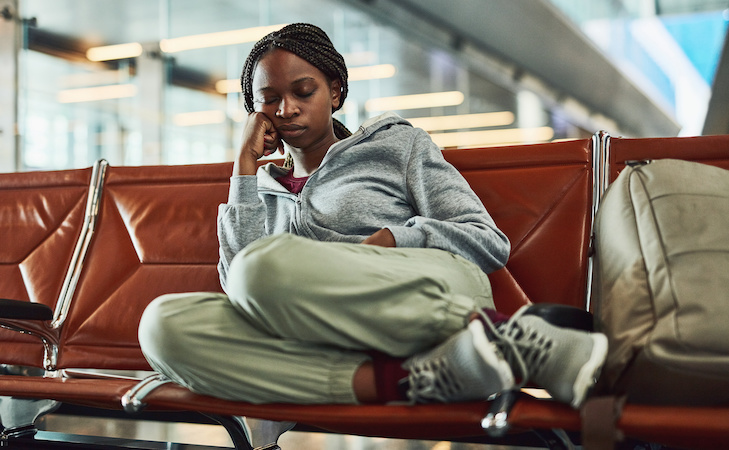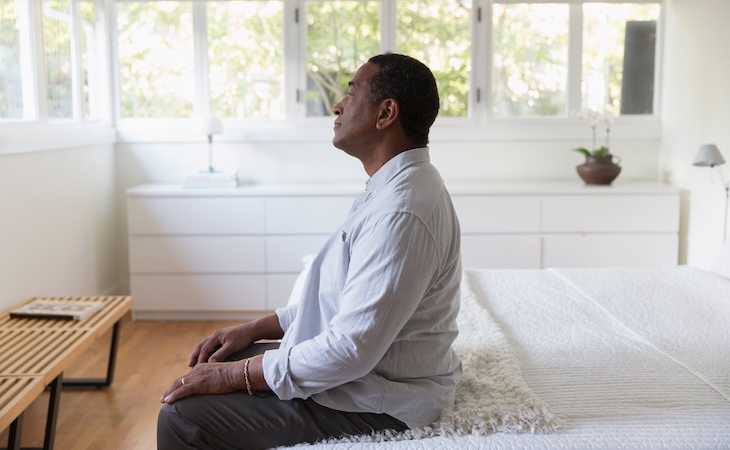There’s nothing that messes with sleep like crossing time zones and spending hours in high-altitude limbo. One of my favorite hacks for 18+-hour journeys is scheduling a long layover in a sleep-friendly airport.
Yes, you read that right: I choose to sleep in airports. Everyone is different, but I feel fresher with a few hours of horizontal shuteye versus stringing together several long flights without a break.
Sleeping in airports can be challenging, but it’s not impossible. Whether you have a long layover or your flight has been delayed or canceled, this article has practical tips for sleeping at the airport so you can arrive well-rested.
Can you sleep in an airport?
You can sleep in most airports, but there may be restrictions on exactly where or how long you can snooze. Some terminals close at night. Some airports outside the US also have rules against overnighting inside the airport’s secure zone.
Bottom line: Check the airport hours beforehand or ask an airline employee about sleeping arrangements if you’re stuck because of a delay or cancellation.
How to sleep at the airport
1. Do your research
“Some airports deliberately accommodate this sort of thing, with darker areas, lounger seats, quiet zones, etcetera,” says Elen Turner, Lonely Planet guidebook author. “Other airports actively discourage it, or seem to, by not having any such quiet or dark areas and having seats that you can’t lie down on.”
You can find information about sleeping options at specific airports by going to their websites or checking out Sleeping in Airports.
2. Bring sleep-promoting items
An

Blocks out light for restful sleep while protecting the delicate skin around the eyes
and earplugs or noise-canceling headphones work wonders when trying to sleep in a bright, noisy airport. Throw in a large scarf or shawl that can double up as a blanket, and don’t forget to bring a toothbrush and fresh change of clothes!
3. Choose your terminal wisely
You’re sleeping in the airport because you have a connecting flight, right? Then the first order of business is to find out your departure gate.
“You don’t want to be in a completely different terminal and then have to make a quick sleepy dash the next day,” says Turner. “It’s better to set up for the night where you need to be.”
4. Secure your stuff
It’s possible to buy neck wallets or scarves with hidden storage compartments, but I usually keep my passport and phone in my pockets. Using your laptop bag or backpack as a pillow can help keep electronics safe.
If you’re a deep sleeper, consider using a padlock or bike lock to secure your luggage to the bench. Many international airports also have luggage lockers.
5. Find safety and comfort in numbers
Sleeping with strangers might not sound appealing, but many solo travelers prefer to camp out within earshot of others. Nap zones and meditation rooms are popular with overnighters.
Turner also warns against abandoned sections of the airport. She once spent the night in an older, deserted terminal in one airport and woke up with itchy bites all over her body. “There was clearly a reason why nobody else was sleeping there,” she says.
6. Head to an airport lounge
“Get a lounge membership or pay if it’s worth it that much to you,” says Hana LaRock, an American freelance writer who lives abroad. “I have chronic vertigo, and sleep is so important to me!”
Most major airports have a collection of lounges with spacious bathrooms, quiet areas, and sometimes even shower facilities. Frequent travelers should consider paying for Priority Pass, which unlocks access to more than 1,000 airport lounges worldwide. Many airport lounges also offer one-time passes.
7. Or splash out on an airport hotel or sleep pod
I was once stuck in Singapore Changi Airport for three days. The airport hotel—which charges by the hour—isn’t cheap, but it was worth it to spend a few hours each night sleeping in a real bed with a private bathroom attached.
Some international hubs have multiple hotels or sleep pod options inside the secure zone. Airport hotels look much like their non-airport counterparts (though rooms often don’t have a window).
Sleep pods, on the other hand, are compact, one- or two-person spaces designed only for sleeping. Some sleep pod rentals include access to shower rooms.
8. Don’t forget your bedtime routine
Never underestimate the calming power of ritual. Getting ready for bed at the airport might not look like your everyday relaxing bedtime routine, but washing your face, brushing your teeth, and changing into comfortable clothes helps signal to your body and brain that it’s time to rest.
To improve my odds of a better night’s sleep while traveling, I add a couple of drops of lavender oil to a dollop of lotion before moisturizing my face and hands.
9. Dress in layers
The temperature between airports and airplanes can vary dramatically. Whether you prefer athleisure or loose, breathable cotton clothes, you’ll sleep better by dressing in comfortable layers.
A rule of thumb: Airports in North America and parts of Europe tend to run cold, while terminals in tropical climates feel hot and humid by comparison.
Turner once slept in Toronto Pearson Airport after a flight from Costa Rica. “One of the coldest nights of my life,” she recalls.
10. Set an alarm
Whether you plan to sleep deeply or not, it’s a good idea to set your alarm for at least one hour before takeoff.
An hour should be enough time to fully wake up, freshen up, and get to the gate well before it closes—usually 15 to 45 minutes before the plane’s scheduled departure.
FAQs
How do you sleep comfortably at the airport?
If you can’t or don’t want to spend money on an airport hotel, sleep pod, or lounge, you can still get a few hours of rest at an airport by scouting out a good location and wearing comfortable layers, an eye mask, and earplugs or noise-canceling headphones.
Do any US airports have sleeping pods?
Several US hubs have Minute Suites, small private rooms with a desk and daybed sofa that can be turned into a bed. Current locations include:
- Atlanta (ATL)
- Baltimore/Washington (BWI)
- Charlotte (CLT)
- Dallas-Fort Worth (DFW)
- Detroit (DTW)
- Houston (IAH)
- New York (JFK)
- Nashville (BNA)
- Philadelphia (PHL)
- Salt Lake City (SLC)
Is it OK to fall asleep at the airport?
It’s usually not against the rules to sleep overnight at the airport as long as you have a valid boarding pass. Naps are always permitted, if you can find a comfortable, quiet enough spot to fall asleep.
Can you sleep overnight in an airport lounge?
That depends on the airport lounge. Some lounges close at night or have rules for how long you can stay. If an airport lounge is open 24/7 and doesn’t have rules against sleeping, then you may be able to sleep overnight in the lounge’s designated quiet room. Always check the airport lounge website before your trip so you can plan accordingly.
Check out our travel sleep guide for more advice on how to snooze when you’re away from home.




